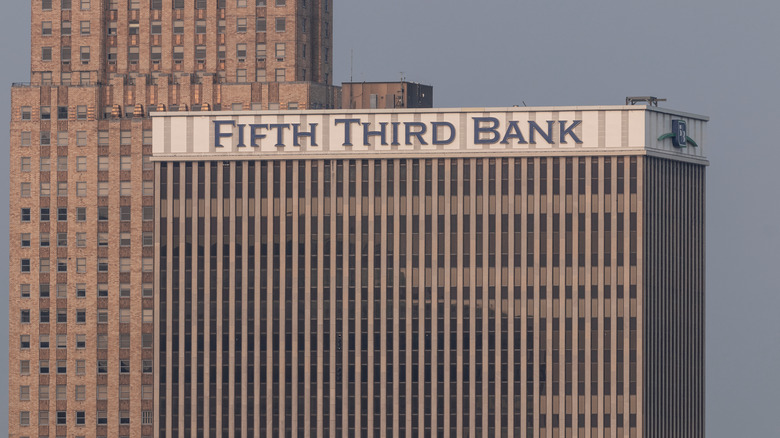This $10.9 Billion Bank Merger Still Won't Come Close To The Largest US Bank
In early October, executives at the Cincinnati-based bank Fifth Third Bancorp announced an agreement to acquire Dallas' own Comerica in an all-stock transaction worth $10.9 billion. The deal is still subject to approval by both banks' stockholders, federal regulatory approval, and other closing conditions. If and when it happens, Fifth Third Bank will bring Comerica's 360 branches and offices into its already existing portfolio of nearly 1,100 branches nationwide. Fifth Third's assets will also swell to $288 billion while its deposits will grow to $224 billion.
Yet while Fifth Third's absorption of Comerica is a big deal, it still won't become the largest bank in the U.S. That title belongs to JP Morgan Chase, a mammoth financial institution that does business as Chase Bank. Chase has about 5,000 branches and 15,000 ATMs across the country. According to data published by the Federal Deposit Insurance Corporation, as of Q2 2025, it has nearly $3.8 trillion in assets and at least $2.1 trillion in deposits.
How did Chase get so big? It wasn't just by increasing the annual fee of its perk-filled Sapphire Reserve credit card to $795. It was through mergers. In fact, JP Morgan Chase was formed by more than 1,200 financial institutions. One of those institutions was the Bank of Manhattan, an organization founded by Aaron Burr in 1799 prior to becoming vice president of the U.S. in 1801.
A history of U.S. bank mergers
JP Morgan Chase's history is so filled with mergers and acquisitions that it's easy to get lost. Among the more notable was when Chase National Bank merged with the Bank of Manhattan in 1955. Then, in 2000, J.P. Morgan & Co. merged with Chase Manhattan. Four years later, J.P. Morgan Chase merged with Bank One and opted to lose the periods in "JP." In 2008, JP Morgan Chase also took over failed banking giant Washington Mutual in a $1.9 billion deal that gave it access to more than 5,000 branches across the U.S., some of which were later closed.
Mergers were how other bank giants grew over the years as well. This includes Bank of America, the second largest bank in the U.S. Although it started in California in 1904, Bank of America was originally known as the Bank of Italy. As of Q2 2025, it had nearly $2.7 trillion in assets and about $2 trillion in deposits. Mergers also enabled Wells Fargo to become the third largest bank in terms of deposits (around $1.4 trillion) and fourth largest in terms of assets (about $1.8 trillion).
Also notable was the merger of two popular credit card companies in May 2025, which propelled Capital One from being the ninth largest bank in terms of assets ($491 billion) to the sixth largest as of Q2 2025 ($649 billion).
Fifth Third's path toward growth
So, where will this pending merger put Fifth Third Bank in the U.S. banking size hierarchy? As of Q2 2025, Fifth Third had more than $209 billion in assets and $168 billion in deposits. Based on the FDIC's data, that puts it 21st in terms of assets and 20th for deposits.
Fifth Third asserts that its absorption of Comerica would make it the ninth largest bank in the country. But, if this is based on the FDIC's Q2 2025 figures (which will likely shift as bank deals consummate and fall apart), $288 billion in assets would make Fifth Third the 13th largest bank in the assets category, one place below TD Bank, which has at least $356 billion in assets despite closing more than 10 branches in 2025. Having $224 billion in deposits would make Fifth Third the 12tht largest U.S. bank in that category, above Morgan Stanley Private Bank's $212 billion in deposits.
However, Fifth Third has plans to grow even further. The merger with Comerica makes it the largest retail bank in Michigan and a top-five share bank in the Southeast, Texas, Arizona, and California. Plus, Fifth Third already has plans to open another 200 locations in the Southeast U.S. by 2028. Fifth Third bankers also expect to have more than half of its branches in the Southeast, Texas, Arizona, and California by 2030.


